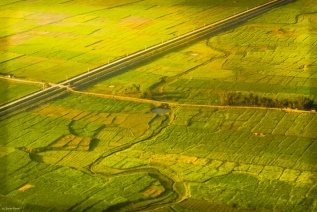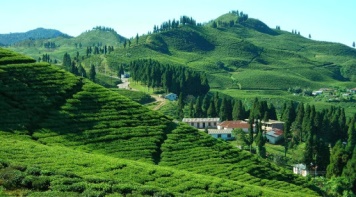Geography of Nepal
Geographly, Nepal measures about 880 kilometres (547 mi) along its Himalayan axis by 150 to 250 kilometers (93 to 155 mi) across. It has an area of 147,181 square kilometers (56,827 sq mi).
Nepal is landlocked by India on three sides and China's Tibet Autonomous Region to the north. West Bengal's narrow Siliguri Corridor or Chicken's Neck separate Nepal and Bangladesh.
Nepal is divided into three belts: Terai, Pahad and Himal, which forming south-to-north transects.
From east to west, it is divided into three major river system, Koshi, Gandak / Narayani and Karnali {including the Mahakali along the western border}, all tributaries of the Ganges river.
Terai Region

Terai is a low land region containing some hill ranges. Terai is nearly up to 600m high from the sea level. Looking out for its coverage, it covers 17% of the total area of Nepal. The Terai (also spelled Tarai) region begins at the Indian border and includes the southernmost part of the flat, intensively farmed Gangetic Plain called the Outer Terai.
This lowland belt is characterised by tall grasslands, scrub savannah, sal forests and clay rich swamps use for irrigation and agriculture. This region also hosts Asia's flagship species including Tiger and Asian Rhino and Elephant.
Pahad / Hilly Region

Hilly region altitude ranges from 600 to 3300m from the sea level and situated south of the Himal. This region does not generally contain snow. It covers 68% of the total area of Nepal. It includes the Kathmandu & Pokhara Valley, the country's most fertile and urbanized area.
Two major ranges of hills, commonly known as the Mahabharata Lekh and Siwalik Range (or Churia Range), occupy the region. In addition, there are several intermontane valleys.
Himal Regionn

Himal is a mountain region containing snow. The Mountain Region begins substantially rising above 3,000 metres (10,000 ft) into the subalpine and alpine zone which are mainly used for seasonal pasturage.
By geographical view, it covers 15% of the total area of Nepal.
Nepal contains the highest mountain range in the world. Eight of the fourteen eight-thousanders are located in the country, either in whole or shared across a border with China or India. Nepal has the highest mountain in the world, Mount Everest.